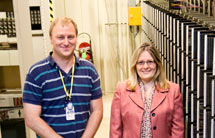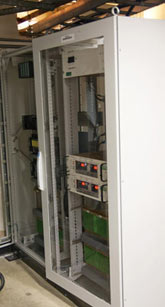
Handy Links
SLAC News Center
SLAC Today
- Subscribe
- Archives: Feb 2006-May 20, 2011
- Archives: May 23, 2011 and later
- Submit Feedback or Story Ideas
- About SLAC Today
SLAC News
Lab News
- Interactions
- Lightsources.org
- ILC NewsLine
- Int'l Science Grid This Week
- Fermilab Today
- Berkeley Lab News
- @brookhaven TODAY
- DOE Pulse
- CERN Courier
- DESY inForm
- US / LHC
SLAC Links
- Emergency
- Safety
- Policy Repository
- Site Entry Form

- Site Maps
- M & O Review
- Computing Status & Calendar
- SLAC Colloquium
- SLACspeak
- SLACspace
- SLAC Logo
- Café Menu
- Flea Market
- Web E-mail
- Marguerite Shuttle
- Discount Commuter Passes
-
Award Reporting Form
- SPIRES
- SciDoc
- Activity Groups
- Library
Stanford
Around the Bay
Upgrade of Linac Safety System Continues
In 2007, SLAC's Accelerator Engineering Controls Department performed the first in a series of planned upgrades to the Personnel Protection System that safeguards staff working with the linac's accelerator systems. The next phase of the work is now in progress.
The project, managed by Kristina Turner, consists of bypassing an intricate array of relays in Building 3, the home of SLAC's original Central Control Room, and installing a new PPS that depends on modern programmable logic controllers, or PLC, instead of the original electromechanical relays. Matthew Cyterski, the group's expert on the type of PLC being installed, said he thinks the upgrade is long overdue.
"The relay system is based on 1940s telephone technology," he said. In the 1960s, when the Building 3 control room was built, such technology was considered the most reliable, most extensively tested technology available, according to Cyterski.
Now, as then, the PPS stands guard over not only the linac but all SLAC accelerator facilities. It both protects people against inadvertently entering the accelerator tunnel during operation and prevents unauthorized access to the beamline. Should someone somehow breach its safeguards, the PPS shuts off the beamline to prevent injury.
Construction of the Linac Coherent Light Source, launched in late 2006, provided the necessary impetus to begin replacing the now 70-year-old technology. The original PPS system worked as a single unit, which meant that what happened in Sectors 1–20 of the linac could not be separated from what happened in Sectors 21–30, the portion used for the LCLS. Work to decouple the two segments offered a perfect opportunity to upgrade the PPS. Once the LCLS was up and running with a shield wall in place between the two linac segments, the time came to start upgrading the safety system for the first two-thirds of the linac.
The upgrade had not been undertaken previously for two main reasons, according to Turner, the first being that the legacy system still works. As for the second reason—she gestured to a scaffold of wiring rising several feet high.
"There's copper wire here going out to every single sector," she explained, "and coming back." A complete upgrade would involve replacing miles of cable with fiber optics. This is the long-term plan, according to Turner, but the requirements of the project call for a phased approach. The first phase, currently being executed, is to build and put into operation a distributed network architecture for the PLCs.
Upgrading the old system is definitely a challenge, Turner said, but her group has received a boost from colleagues from the Thomas Jefferson National Accelerator Facility, another national lab moving to advanced PLC safety systems. Two Jefferson Lab Safety Systems engineers have been working almost full-time on the design of the new PPS.
Turner hopes to finish the cut over to the new system—and cut the old relays out of the equation—during the planned LCLS shutdown in March 2011. Along with providing a state-of-the-art PPS and enabling the lab to reclaim the Building 3 floor space currently housing the old relay system, this project will be a technological leap for the Controls Department. At the same time, Turner said the occasion will mark a milestone of another kind for SLAC.
"Legend has it," she said, "that this is the last working system," on the ground floor of Building 3, the original heart of the linac. "This [old PPS] is something we've been taking care of for a long time."
—Lori Ann White
SLAC Today, October 28, 2010

